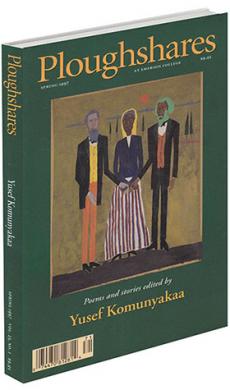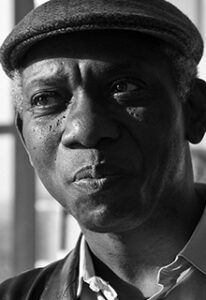rev. of The Broken World by Marcus Cafagña
The Broken World
Poems by Marcus Cafagña. Univ. of Illinois Press, $9.95 paper. Reviewed by Joyce Peseroff.
The inhabitants of Marcus Cafagña’s broken world beat against the bars of circumstance and fate as the poet fixes them with the empathy of attention. Whether in the kid shooting baskets who’s “had it / with the Crisis Center” (“The Way He Breaks”) or the girl on the freeway overpass whose face, pressed against the fence, is crosshatched with anger, Cafagña imagines both dignity and possibility: the boy leaps like “someone drowning, / pushing his weight / up off the bottom,” and the girl throws not herself but a bandanna “red as a cardinal,” “like a life to the horizon” (“Black Girl on the Overpass”).
Cafagña’s art attempts to make something whole, sane, and tender from the shattered lives he witnesses and cares for. To the aunt whose throat was knifed by her drug-addicted son, Cafagña offers the notion that “a scar is something / faithful, a way her skin / / will never give him up” (“Something Faithful”). The poet embraces those irreparably harmed by twentieth-century realities, including the runaway boy in the title poem whose “. . . parents beat him / or their priest wedged fingers / between his legs as if searching / / for the smallest bud of lilac.” In several poems for his aunt Sarah, Cafagña writes movingly of a Holocaust survivor who “went mad on a train” and who envisions in her Brooklyn apartment “the superintendent’s / SS armband, how at night / he floated through floors . . . / . . . filled / vacuum cleaner bags / with dirt” (“Dybbuks”).
The poems rush headlong, preferring enjambed to end-stopped lines, as if trying to outrace the sad histories they narrate. The poet tactfully reserves for the book’s last section the personal tragedy of his wife’s suicide. Perhaps the most poignant example of Cafagña’s eye for plain but eloquent detail occurs in “All the Bells”: “When I drive past our old brick townhouse / I see them — red and yellow — / the tulips you planted last spring / risen from the ground after winter.” Color, isolated visually as well as verbally in a world devoid of color (“old brick townhouse”), rises as the woman will not, while the poem’s music lowers the reader from “house” to “ground.”
The Broken World serves to remind that “. . . danger, like beauty, distorts its shape / in rehearsal, meaning fades like starlight / splayed through curtains, and soon its signals / cannot be read” (“June Bug”). Cafagña doesn’t muddle the past with false nostalgia or the future with false hope, but his first book interprets the signals of silenced lives and provides a measure of redemption.
Joyce Peseroff’s most recent book of poems is A Dog in the Lifeboat
(Carnegie-Mellon).

